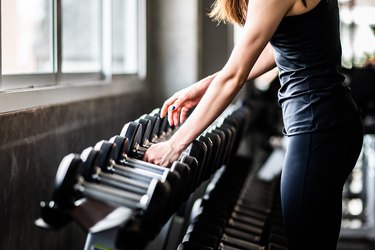
It can be very discouraging to have your workout routine disrupted by pain. There are a number of possible reasons why your forearm hurts after working out. If you perform biceps curls with weights, experiencing a burn as you approach fatigue, and occasionally feeling sore the following day, are normal reactions to exercise. However, injuries caused by resistance training are relatively common, and you should consult your physician if you have pain that is intense or persists.
Read more: Weights & Forearm Pain
Video of the Day
Video of the Day
Forearm Recruitment During Curls
Although biceps curls are considered an isolation exercise for the biceps, your forearms are also involved in the movement. If you only experience forearm pain after your workout or during the last few reps of each set, it could be the result of your forearms fatiguing before your biceps. Experiment with different curl variations, such as concentration curls or cable curls, to find a movement that allows you to really feel the contraction in your biceps.
You might also avoid forearm pain after lifting weights by strengthening your forearms with some specific exercises for the muscle group, such as wrist curls and reverse wrist curls. Warm up your forearms with five to 10 minutes on an arm bike and forearm stretches prior to weight training to help reduce the risk of injury and pain.
Elbow Structure and Wrist Position
Depending on the structure of your elbows, you may be anatomically predisposed to pain in your wrists and lower forearms when performing biceps curls with a barbell. This is especially likely if you are a woman. If there is a significant angle — called the carrying angle — at your elbow between your forearm and upper arm. When your arms are hanging relaxed, barbell curls will place excessive stress on your wrists. Use an E-Z bar instead of a straight bar when performing barbell curls, or replace the exercise with a dumbbell variation.
Delayed-Onset Muscle Soreness
Delayed-onset muscle soreness, or DOMS, is the soreness that you begin to feel 12 to 48 hours after an intense workout. Soreness in your forearms, following a strenuous bout of biceps training, is caused by micro-damage to the muscles and is not usually cause for concern. However, you should avoid training your biceps or forearms again until the DOMS has subsided. Massage and stretching exercises for the forearms can help to alleviate the pain associated with DOMS.
Read more: Forearm Tendonitis and Barbell Curls
Forearm Pain After Workout
Forearm pain after a workout can also signal an injury in the area. It is important to learn the difference between soreness and pain caused by a legitimate injury. Common injuries of the forearms include muscle or tendon strains, ligament sprains and tears in any of these structures. If the pain you experience in your forearms during biceps curls is sudden or severe, stop training immediately and seek medical advice. Warming up your forearms with some light sets and stretches, before starting your main workout, can help you avoid injury.
- American College of Sports Medicine: "Delayed Onset Muscle Soreness (DOMS)"
- Massachusetts General Hospital Sports Medicine: "Wrist and Elbow Strengthening and Stretching Exercises"
- International Journal of Current Pharmaceutical Review and Research: "The Carrying Angle of Elbow - A Correlative and Comparative Study"